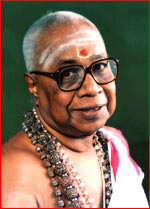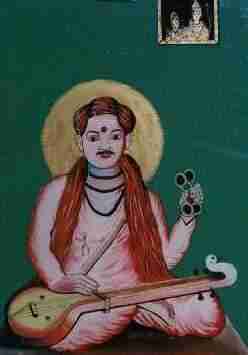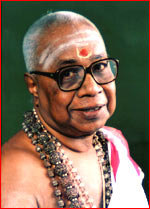Pancharathnam Series -JagadhAnandhakAraka - Part 1
| Dear All, Sri SeethA lakshmana hanumath SamEtha Sri Sathguru prAnanAthAya jagadhAnandhakArakAya Sri Kothanda kalyAna pattAbhirAmachandra parabrahmanE nama: (Let us all invoke the blessings of the one who is always with SeethA dEvi, Lakshman and Hanuman and The one who is the Lord of Sathguru thyAgabrahmams life and the One who is the creater of all the Joy in this world. The one who is worshipped and (enjoyed) as KOthanda RAman,kalyAna rAman and PattAbhiRAman and The one who is none other than the para brahmam.)  I am very pleased indeed to invite you all to be here and read,enjoy and benefit from the series of posts that I will be writing up on from this post onwards, for many weeks and months together, on the great pancharathnams of sathguru thyagabrahmam. With the blessings of my mAnasIka guru, sathguru thyAgabrahmam and all the sathbhAgawathAs of the present and past and with the permission and blessings of Sri Oppilappan KOil varadhAchARi Sriman V. SadagOpa Iyengar, who has authored a 350 page book(monograph) in tamil on the pancharathnams of Sathguru. Not very long time back, the book was made available online for the benefit and the enjoyment of all. This write up will most likely be an abridged and a customized version of the monograph along with my own personal anubhavams. I am sure that this write-up will bring the anugrahams of Sathguru and seethArAmachandran to everyone who reads with/ without great interest. Just as a reminder, let me alert the reader to please read the Pancharathna mAhAthmyam post that i wrote a few weeks back. (archived) Before I start, I would like to salute all the great souls, both present and pAst. EndarO mahAnubAvulu, Anthariki Vandhanamulu. (Of course, we will all learn the greatness of this krithis for which alone nithyArAdhanA can be performed for sathguru) The first pancharathnams that our Sathguru composed was set to tune in the nAtAi rAgam , that symbolifies veerya rasam (heroism).  We all know that one main reason bhagawan takes an avathar is for dhusta nigraham (defeat/destroy the evil).In rAmA avathar the greatest evil force was present in the form of rAvanan, who was a slave of the ten senses. Thus, Sriman nArAyanan willed to take avathAR as a human by the request of all the dEvAs to defeat rAvana and establish peace and happiness on earth. He could have done that very easily just like he killed hiranyakasipu in narasimha avathARam. But, he chose to be born to Dasharatha Chakravathy (the one who has controlled to 10 senses) , slained the rAkshasAs like ThAtakA, subAhu and marEEchan, married SeethA dEvi, observed 14 years of vAna vAsam (of exile), sought for the golden deer that seethA dEvi wished for and while doing so , he lost his dear seethA dEvi to RAvanan. He then went searching for his beloved. While doing so, he blessed and gave mOksha to jatAyu, the great old bird and then he went to old shabari's hut, tasted the fruits offered by her and granted her liberation. We all know that one main reason bhagawan takes an avathar is for dhusta nigraham (defeat/destroy the evil).In rAmA avathar the greatest evil force was present in the form of rAvanan, who was a slave of the ten senses. Thus, Sriman nArAyanan willed to take avathAR as a human by the request of all the dEvAs to defeat rAvana and establish peace and happiness on earth. He could have done that very easily just like he killed hiranyakasipu in narasimha avathARam. But, he chose to be born to Dasharatha Chakravathy (the one who has controlled to 10 senses) , slained the rAkshasAs like ThAtakA, subAhu and marEEchan, married SeethA dEvi, observed 14 years of vAna vAsam (of exile), sought for the golden deer that seethA dEvi wished for and while doing so , he lost his dear seethA dEvi to RAvanan. He then went searching for his beloved. While doing so, he blessed and gave mOksha to jatAyu, the great old bird and then he went to old shabari's hut, tasted the fruits offered by her and granted her liberation.  After that he helped Sugrivan and got rid of his grief by killing his enemy VAli. He befriended the monkeys and then gave Hanuman the power to cross the sea, who gave sita DEvi, her Lords ring, comforted her and made her happy by chanting ramA nAmA. After that he helped Sugrivan and got rid of his grief by killing his enemy VAli. He befriended the monkeys and then gave Hanuman the power to cross the sea, who gave sita DEvi, her Lords ring, comforted her and made her happy by chanting ramA nAmA.  Finally , he crossed the sea with help of the bridge built by monkeys and fought war with rAvana and his army , performed abhaya pradhAnam(protection) to Vibheeshan and killed rAVanan by using brahmAsthram. He also offered his sandals to bharathan and removed his suffering. He also have absolution(ShApa VimOchanam) to Ahalya when he stepped on a stone, which was none other than ahalya who was cursed to a stone by GauthamA. This is real heroism, saving some one who can never be saved by anyone else. (sooran). Our sathguru introduces such a valiant rAman , his ishtanAthan as jagadhAnandhakArakan , the one who gives happiness to everyone in this world in his first nAtai pancharathnam. Finally , he crossed the sea with help of the bridge built by monkeys and fought war with rAvana and his army , performed abhaya pradhAnam(protection) to Vibheeshan and killed rAVanan by using brahmAsthram. He also offered his sandals to bharathan and removed his suffering. He also have absolution(ShApa VimOchanam) to Ahalya when he stepped on a stone, which was none other than ahalya who was cursed to a stone by GauthamA. This is real heroism, saving some one who can never be saved by anyone else. (sooran). Our sathguru introduces such a valiant rAman , his ishtanAthan as jagadhAnandhakArakan , the one who gives happiness to everyone in this world in his first nAtai pancharathnam. In this krithi, there are 10 charanams with a pallavi and anupallavi. In this post we will discuss the pallavi and anupallavi. The charnams will be covered and completed in small steps in later posts. Out of the 10 charanams , three of them have the mudra of Sathguru as "ThyAgarAjanutha, Sri ThyAgarAja sannutha and ThyAgarAjAthinutha" >Prof SAmbamoorthy says that "This krithi in nAtai is a garland of panegyrics on Sri RAma, a Sangeetha Rahasya pradarshini ( Musical revelations) and as ideal for voice-training exercises. It is also a belief that this krithi and the ARabhi RAgA krithi, Saadhinchane were composed by Sathguru by the request of ThanjAvur RAmA rAo, one of his primary disciples. Sri rAmA rAo requested his guru to compose some krithis for bhagawath ArAdhanam(worship) and sthuthi (praise) and to fulfil his request it is beleived that Sathguru has composed the krithis and blessed him. One of the less known facts about this krithi is that when the group of words praising the Lord are separated, one ends up with Ashtothra Shatha nAmAvali like Om jagandhAnandhakArakAya nama: Om Jaya jAnaki prAnanAthAya nama: Om gaganAthipa sathkula jAya nama: Om rAja rAjeshwarAya nama: Om SugunAkarAya nama: Om SuraSEvyAya nama: (Click here to listen ) Our sathguru has embellished the krithis with lots of beautiful swarAlankArAs. Prof SAmbamoorthy has observed the following 1. Starting from the third charanam ," Indra neela mani sAnnipApa" until the 7 the charanam "PurAna pursha" , the charnams start uniformly with "PA pa SA PA pasA" 2 .In the 8th charanam, when one hears the sound of the pranavA (OM), there is a UllAsitha Gamaka prayOgA ( a blissful tune) that rises from madhya shadjama ( Sa) to thArasthAyi ShadjamA. Let us now start with the pallavi. JagadhAnadhakArakA jaya JAnaki PrAna nAyakA" Our Sathguru introduces his ishtanAthan as jagadhAnandhakArakan ,who destroys the fear and blesses happiness and to the ones who have come seeking his refuge, even when one has done so many aparAdhams (sins). He is the one shows no disctinction between his friends and enemies. For eg, he gave mOkshA to rAvana just like he gave mOkshA to jatAyu and simlarly he gave mOksha to ThAtakA in the same way he gave MOksha to Shabari. He is the one who removed the fear of the monkey king , Sugreevan and blessed him with happiness. He removed the troubles of Vibheeshanan, who sought his feet and blessed him with the kingdom of LankA. By killing rAvanan, he gave mOkshA to him and happiness to the world and beyond. Sathguru, thus worshipped, SReeRAmachandran, the one who was born in the Raghuvamsa , the one who blesses and comforts his devotees like the moon and the one who gives happiness to the heart (kumudha pushpam) of SeethA dhEvi as "jagadhAnandhakArakA, jaya jAnaki prAna nAyakA , hey rAmA". The following slOka highlights the same SreeRAmachandra karunAkara rAghvEndra RAjendra Chandra raghuvamsa samudra | Sugreeva NEthrayugaLothpala Poornachandra SeethAmana: Kumudha chandra nAmO NamasthE || When the krithis is rendered, the pallavi is rendered for the longest time with lots of different variations (sangathIs) . The sangathis are for us to enjoy the sree rAmachandran as myriad of ways. Everytime one sangathi is rendered, there is a bhAva attached with it. Each of them, allows us to enjoy sreerAmachandran as jagadhAnandhakArakan in a myriad of different ways, the gunA that is highly enjoyable. Click here to listen. Let us go to the anupallavi gaganAdhipa sathkulaja rAja rAjeswarA| SugunAkara SurasEvya bhavya dhAyakA sadhA sakala || Here sathguru celebrates SriRAmachandran as the one who rose out of the Surya vamsa( SUryA race) and as king of all the kings. In SandhyAvandhanam, the sun (sooryan) is introduced as parabrahamam.(AsAvAdhithyO brahma) It is beleived that the one who worships the sun as parabhramam during the its rising and setting time will be blessed with everything (Taithreeya brAhmanam). SreerAmachandran is born out of such a race. The same emotion is expressed by hanumAn is Sri SeethA rAma sthOthram RaghUnAm Kuladheepam cha,NimeenAm kuladheepikAm | SUrya Vamsa Samuthbutham, SOma vamsa SamuthbavAm || In the next part of the anupallavi, our sathguru praised and enjoys his Lord as SugunAkara SEvya bhavya dhAyakA sadhA sakala He praises him as sugunAkaran , the one who as per , ramayathE Ithi RAma:, blesses everyone and makes them happy by his sathgunAs (SugunAS). This is also reflected in the following slOkam of vAlmIkIs Tvam Hee sathya vrathasUrO: dhARmikO Thrta Vikrama: | PareekshyakAri SmrithmAn NisrushtAthmA SUharuthSucha || He praises SreerAmA as the one who keeps up the word, the one who always stick to the truth, the one with unlimited valuor, the one who always comes to the right conclusion and the one who always remembers the helps of his friends. In the next part, sathguru thyAagabrahmam praises his Lord , with such sugunAS as the one praised and worshipped by the SuRAs (dEvAS) In the last verse, he worships him as "SadhA sakala dhAyakA" . The word rAma is made up of a RA and a mA. There are so many evidences about the benfits derived out of chanting this thARaka nAmA. In RAmayana written by the tamil poet, kamban, it is said that "Nanmayum Selvamum nALum NalkumE Thinmayim pAvamum Sithanthu ThEyumE | Jenmamum marnamum IndriTheerumEy Inmayey IrAma Endru Irandu EzhuthinAl || He says that , by uttering the "RAma", we will all be blessed with eveything auspicious even within this birth. Also, all the evil and ill luck will vanish, there wont be birth and death and will certainly attain MOkshA (Liberation). Click Here to listen to the anupallavi. (Will be continued) With sathguru dhivya kamala pADha smaranams, AdiyEn thyAgayya and rAmAnuja dAsan Sarvam Sathguru prAnanAthAya JagadhAnandhakArakAya SeethARAmchandrArpanam. |





 Doubt no.1: Is it that the "raama naama sukhi" is no body else other than sivan? This doubt comes because thyaagaraaja asked the question sukhi evarO? and completed the krithi without answering the question.
Doubt no.1: Is it that the "raama naama sukhi" is no body else other than sivan? This doubt comes because thyaagaraaja asked the question sukhi evarO? and completed the krithi without answering the question.




